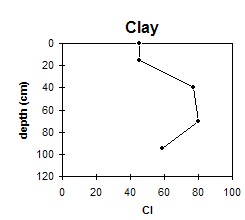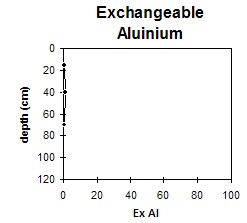ASSS4
| Location: Merricks | Australian Soil Classification: Haplic, Eutrophic, Red FERROSOL |
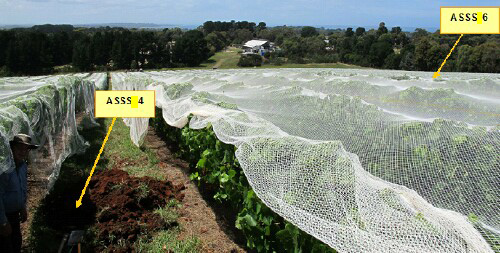
ASSSI 4-6Landscape
Soil Profile Morphology:
Surface Soil
| A1 | 0-15 cm | Dark reddish brown (5YR3/2); light clay fine sandy; strong medium polyhedral parting to fine polyhedral structure; rough fabric; strong consistence dry; pH 6.3; clear to gradual change to: | 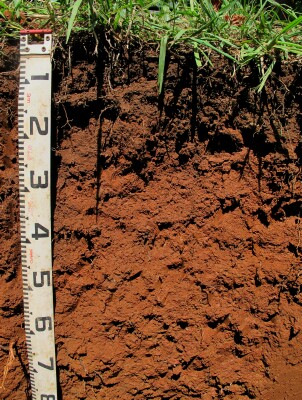 ASSS 4 Profile |
| Subsoil | |||
| B21 | 15-40 cm | Dusky red (2.5YR4/4) heavy clay; strong coarse sub-angular blocky, parting to fine polyhedral structure; smooth fabric; firm consistence moist; pH 5.6; gradual change to: | |
| B22 | 40-70 cm | Dusky red (2.5YR4/5) medium heavy clay; strong medium polyhedral parting to very fine polyhedral structure; smooth fabric; firm consistence moist; pH 5.7; gradual change to: | |
| B23 | 70-95 cm | Dusky red (2.5YR4/5) with few faint coarse brown (7.5YR4/4) mottles; medium heavy clay; strong coarse sub-angular blocky, parting to fine sub-angular blocky structure; firm consistence moist; pH 5.5; gradual change to: | |
| B24 | 95+ cm | Dusky red (2.5YR4/5) with few distinct very coarse brown (7.5YR4/4) mottles; firm consistence moist; contains few (2-5%) fine manganiferous stains. | |
Key Profile Features:
- Well structured soil profile (parting to fine polyhedral peds)
pH | Salinity Rating | |||
Surface (A1 horizon) | Slightly Acid | Low | Non-Sodic | - |
Subsoil (B21 horizon) | Moderately Acid | Very Low | Non-Sodic | - |
Deeper subsoil (at 90 cm) | Strongly Acid | Very Low | Non-Sodic | - |
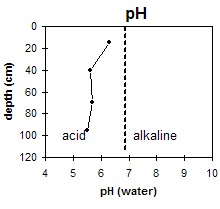 The surface horizon is slightly acid. The subsoil is moderately acid; becoming strongly acid with depth. | 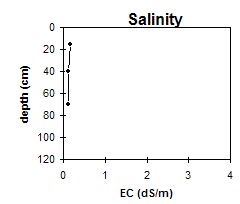 The salinity rating is low throughout the soil profile | 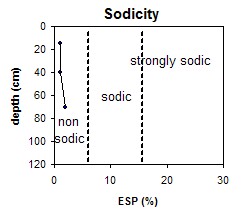 The profile is non-sodic throughout. |
|
|
Horizon | Horizon Depth | pH (water) | pH CaCl2 | EC 1:5 | Organic Carbon g/2100g | Exchangeable Cations | |||
Ca | Mg | K | Na | ||||||
Meq/100g | |||||||||
A1 | 0-15 | 6.3 | 5.7 | 0.16 | 6.5 | 14 | 6.7 | 1.3 | 0.27 |
B21 | 15-40 | 5.6 | 5.3 | 0.12 | 0.8 | 4.2 | 6.3 | 0.81 | 0.31 |
B22 | 40-70 | 5.7 | 5.4 | 0.12 | 2.5 | 6.5 | 0.16 | 0.56 | |
B23 | 70-95 | 5.5 | 5.0 | 0.12 | |||||
B24 | 95+ | ||||||||
Horizon | Horizon Depth | Ext. Iron g/100g | Ex Al mg/kg | Ex Ac meq/100g | Wilting Point pF4.2 g/100g | Coarse Sand (0.2-2.0mm) % | Fine Sand (0.02-0.2mm) % | Silt (0.002-0.02mm) % | Clay (<0.002mm) % |
A1 | 0-15 | 6.7 | 16 | 15 | 24 | 13 | 45 | ||
B21 | 15-40 | 8.4 | 1.14 | 14 | 5 | 9 | 8 | 77 | |
B22 | 40-70 | 8.1 | 1.26 | 13 | 5 | 7 | 8 | 80 | |
B23 | 70-95 | 5 | 28 | 7 | 59 | ||||
B24 | 95+ |
Management Considerations
Whole Profile
- Red Ferrosols (formerly referred to as ‘Krasnozems’) have high levels of free iron oxide which gives them a high degree of structural stability. However, due to their high iron oxide contents these soils tend to "fix" phosphorus which makes it less available to plants. Regular phosphorus application can assist in overcoming such a deficiency. Addition of molybdenum may also be required. This can be assessed by plant tissue analysis of clover. Zinc and copper can also be 'fixed' by high iron oxide contents.
- These soils are deep and very well drained due to their strongly developed structure. Water infiltration rates will be high unless significant compaction has occurred.
- Plant available water capacity (PAWC) tends to be high for these soils – with relatively high effective rooting depths.
- Management strategies for all soils should include: increasing organic matter levels in the surface soil, minimising the degradation of soil aggregates and porosity, promoting the development of stable biopores, improving the calcium status of the cation exchange complex (particularly when sodium is a significant part), and breaking up any hardpans. Less frequent tillage, using less aggressive implements and working the soil at its optimum moisture content, can all assist in maintaining soil aggregation and porosity, as well as reducing the breakdown of organic matter.
- These soils are naturally well structured and the surface horizons tend to be friable when moist. Coughlan et al. (1973) noted that heavy applications of superphosphate can dissolve large amounts of iron and aluminium from the soil and may result in reduced aggregation.
- Soil compaction from trafficking can lead to reduced water infiltration and retention as well as an increase in soil strength (resulting in mechanical resistance to roots) and cloddiness. Compaction of these clayey soils can be caused by over-cultivation or trafficking, particularly when the soil is wetter than the plastic limit. Ideally, tillage and trafficking should occur when the soil is drier than the plastic limit (at least down to the depth of cultivation). Compaction on soils such as these can be more serious than on cracking clay soils which tend to self-repair due to their strong shrink-swell capacity.
- A study by Hirst et al. (1992) of Ferrosols in the Warragul region found that wheel traffic has a considerable effect on soil strength (as measured by penetrometer resistance) at the beginning of the growing season. Non-ripped and re-trafficked furrows were significantly more compacted to a depth of 30 cm than un-trafficked or ripped furrows. This compaction resulted in reduced water infiltration (and therefore greater runoff). This has important implications for runoff and soil erosion, particularly early in the growing season when crop cover is minimal and the probability of intense storms is high. Over the course of the growing season, soil strength decreased in compacted furrows. In terms of management, it is recommended that wheel traffic be minimised (especially if the soil is wetter than the plastic limit) to prevent soil compaction. Wheel tracks and other compacted areas can be deep ripped (when dry) or cultivated across the slope to promote infiltration and minimise the potential for runoff.
- When cultivated in a too moist condition, such soils can be prone to form large clods, which can create difficulties when harvesting potatoes. A decline in organic matter levels may also contribute to clod development.
- These soils have a high pH buffering capacity (i.e. require a larger lime application to raise soil pH). Over-liming, however, may result in some micronutrient deficiencies and may also lead to reduced aggregate stability.
- This soil has a reasonably high organic carbon content (i.e. 6.5%). Red Ferrosols generally have high organic matter levels, which enhances soil fertility and aggregate stability. When intensively cropped, organic matter levels will decline and this can lead to some structural degradation and fertility decline. Studies have shown that organic matter is an important source of nitrogen, phosphorus and sulphur in such soils. Organic matter levels can be improved by utilising green manure crops, crop residue retention, minimal cultivation and pasture rotations.
- Management practices which result in increased organic matter levels include: minimum tillage; growing green manure crops; incorporating pasture phases in crop rotations, and retaining and incorporating crop residues (Cotching 1995).
- The nutrient status (based on the sum of the exchangeable basic cations) of these strongly leached soils is not high (particularly below the surface horizon). Fertiliser input is often needed if intensive cropping is to take place. Organic matter is a major source of cation exchange in such soils.
- The relatively high wilting point value for surface horizons of these soils indicates that plants are less able to utilise light rains falling on relatively dry soil, compared to lighter textured soils in the area. Plant available water capacity is, however, is quite high for surface soils due to the higher clay and organic matter contents.
- The subplastic properties of the subsoil can lead to problems with sealing of earth dams. Sealing of dams constructed on such soils can be achieved by compaction at the optimum water content and treatment with sodium tri-polyphosphate or addition of bentonite (Rolfe 1989).
- Exchangeable aluminium levels are low in the moderately acid upper subsoil and not likely to affect the growth of aluminium sensitive species.

